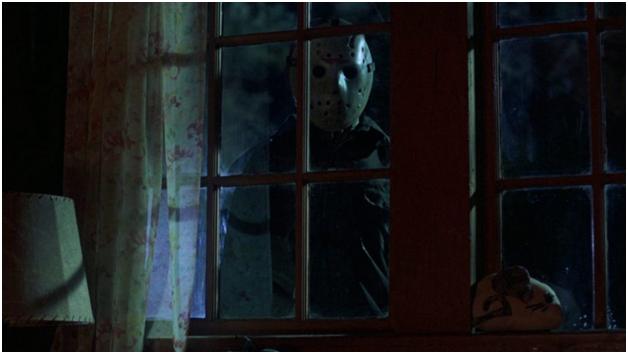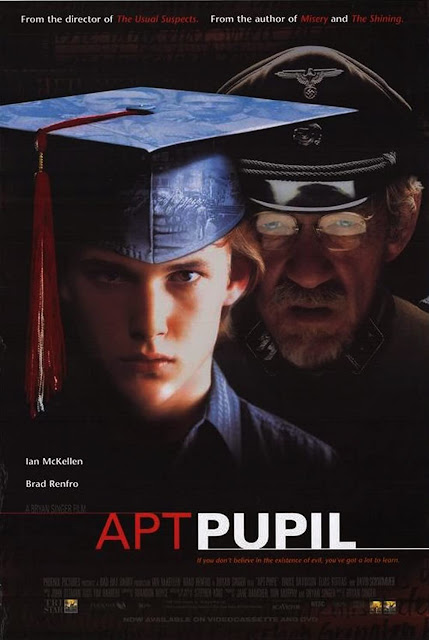Sep 12, 2024
May 29, 2024
May 5, 2021
APT PUPIL (1999)
Stephen King has seen more
adaptations of his written body of work than any other writer living or dead,
except maybe for Bram Stoker, whose novel, Dracula,
has been adapted for a literal, accurate, and confirmed figure of ninety
bajillion times. As such, among these King adaptations, some are classic, some
are decent, and some are best forgotten. His 1982 four-novella collection, Different Seasons, contained the
original stories that would later be adapted into Stand by Me, The Shawshank
Redemption, and then Apt Pupil.
The fourth story, The Breathing Method,
is in the works under the direction of Sinister’s
Scott Derrickson, so the Different
Seasons adaptation game is looking like a clean sweep. Not bad for one
book. (The jealous author in me weeps bitterly.)
Until Derrickson’s adaptation
sees release, Apt Pupil remains the
dark horse adaptation of the book. Having been released to mixed-to-positive
reviews back in 1999 (and mired in controversies/production difficulties), and directed by a post-Usual Suspects Bryan Singer (the X-Men series, Valkyrie), Apt Pupil
has always remained just under the radar in the King world. Headlined by Brad
Renfro (The Client), who died at the age of 25 in 2008, and whose death was overshadowed by
the passing of Heath Ledger one week later, Apt Pupil presents a young, well-to-do high school student and
all-around sociopath Todd Bowden, who deduces that an elderly member of his
community, Arthur Denker (Ian McKellen), is a former Nazi living in hiding
under an alias. Bowden, fascinated with Nazi atrocities (or perhaps just
atrocity in general), first blackmails Denker before cautiously befriending
him, wanting nothing more than to hear all of Denker’s vile holocaust stories.
And Denker, at first backed into a corner, slowly begins to spin the
arrangement to his advantage, until the two get to a point where both are
manipulating each other. As such, only one will likely walk away.
As can be expected by a King
work, Apt Pupil is very dark – not
in terms of gory visuals, but more its tone and its subject matter. There’s no
blacker stain in the world than the atrocities of Nazi Germany during World War
2; even without the grainy black and white photographs of stacked bodies and
emaciated figures, the mere discussion of it is still upsetting enough that Apt Pupil presents as a somber and
by-design upsetting experience. Singer and screenwriter Brandon Boyce don’t
back away from the darkness of the story’s subject matter, although it does
update certain aspects, such as its much more explosive finale (to be expected
in 1999’s immediate post-Columbine era).
Ian McKellen is chilling in his
role as the runaway Nazi, whose villainous turn almost laughs in the face of
his more well-known, and by comparison, lovable, take on the X-Men series’ Magneto (ironically, a
survivor of the holocaust). But in a way, it’s Renfro as Bowden who walks away
as the film’s bigger sociopath, and that’s because he wears the façade of a
sixteen-year-old kid in a varsity jacket and has a pretty girlfriend on his
arm, who society would dictate has the perfect life, and hence, is no one to
worry about. Renfro finds a way through all that and presents an angry,
confused, and severely psychotic kid for whom more teachers would write a
letter of recommendation than recommend him for psychological counseling.
(Sadly, Renfro battled with drug addiction throughout his 20’s, nearly
obtaining the lead in Freddy vs. Jason
before a bizarre incident in which he stole a yacht cost him the role.)
On the triple tier Stephen King adaptation scale, Apt Pupil rests comfortably in the upper-middle ranks. The lead performances and Singer’s direction are top notch, while the screenplay can sometimes meander, with its neutered ending sacrificing much of the impact of King’s original story. Still, it’s certainly one of the better King adaptations, with immense talent on both sides of the camera. Sadly, it’s also more relevant in the modern climate than it’s ever been before.
Oct 25, 2020
Aug 27, 2020
HOUSE (1985) AND HOUSE 2: THE SECOND STORY (1987)




Jul 14, 2020
LET’S RAISE SOME HELL: ‘PET SEMATARY TWO’ IS A MASTERPIECE


I’m so glad I did.
Pet Sematary Two is one of the strangest, darkest, and most uncomfortably funny horror flicks ever produced by a major studio—one directed by a woman, headlined by a 13-year-old kid with more star power than the guy playing his father, and which had absolutely no problem killing multiple children… and mothers… and kittens. (Though I didn’t find any of it remotely scary watching it with adult eyes, I could still recall the parts that did, and the terror that I felt, when I was that young boy renting it from West Coast Video all those years ago.) Originally, Lambert had intended on directly continuing the Creed story with a teenage version of Ellie (played by Blaze Berdahl in the first film), but in a stunning act of boundless misguidance, Paramount was leery about making a teenage girl the lead character in a horror film...even though the studio had just completed a successful eight-film run of the Friday the 13th series, in which the lead in nearly every single entry was a teenage girl. In response, Lambert and screenwriter Richard Outten (Van Damme’s Lionheart) created an entirely new crop of characters while making the obvious choice to maintain its conflict within in the town of Ludlow, the site of the pet cemetery and the Micmac burial ground beyond it.




Jun 13, 2020
HER NAME WAS PAMELA: 'FRIDAY THE 13TH' (1980) TURNS FORTY

The Friday the 13th series will always hold a special place in my heart, regardless of how dumb it became once Paramount Pictures’ eight-film reign ended and the franchise ended up with New Line Cinema. (Jason Goes to Hell is enough to cement my point, but the remake easily earned my hatred.) As a kid, and once the calendar fell on Friday the 13th, catching a mini marathon of the series on TNT, USA Network, or what was then known as the Sci-Fi Channel was always an event. I’d fire up the VCR, grab a VHS tape from the cabinet to sacrifice, and record as many entries as I could, stretching EP mode to its breaking point. Growing up with an old-school mother, the hammer often came down on the movies I rented, so I worked with what I was given, which were edited-for-content, commercial-ridden airings of the least mother-friendly horror series on the planet.

Though Friday the 13th: The Final Chapter is the most popular entry in the series (I won’t argue with that), I often feel that the 1980 original gets overshadowed and dismissed as being that weird entry where the killer is Jason’s mom instead of the marquee maniac we’d all come to love. Even with the maestro of mayhem Tom Savini in charge of the blood and guts, it doesn’t contain the same kinds of outrageous kills that the series would later feature, much like in Savini’s return to the series with The Final Chapter, or 1993’s Jason Goes To Hell, which has nothing going for it except the violence. But there are all kinds of reasons to celebrate the original, even if its own creators still admit to this day that it was a blatant rip-off of John Carpenter’s Halloween.
Friday the 13th offers an honest-to-gosh attempt at creating backstories for its characters, regardless of their superficiality. Alice (Adrienne King) has unknown and unresolved issues in California, Marcie (Jeannine Taylor) had nightmares about raining blood as a kid, Ned (Mark Nelson) is the “funny one,” etc. There’s nothing earth-shattering going on here, and except for some outward capering, their backstories come solely from dialogue and not their performances, as Halloween was so keenly able to do. But that’s okay! Post-Halloween slashers didn’t strive for much beyond a passing resemblance to real life and some nifty kill scenes, and Friday the 13th handles that with ease. Though it’s primarily known as a slasher flick today, putting yourselves into the shoes of an unknowing audience those forty years ago instead reveals a murder mystery at its core, even if clumsily handled. Halloween never played around with “who” the killer was—it’s how the flick opens—and while Friday the 13th is happy to ape Halloween’s slasher aesthetic, it’s also eager to apply a bit of Ten Little Indians, sticking a bunch of characters in an isolated spot and painting several of them as potential killers. Steve Christy (Peter Brouwer), who has a vague romantic history with Alice and seems against her leaving to return home, disappears into town just before bodies being to drop at Camp Crystal Lake, and all while driving a jeep…just like the unseen killer. Crazy Ralph (an incredible Walt Gorney) prophesizes all across town about how the camp is doomed, and how all those who stay there will “never come back again.” These red herrings aside, a cheap final act reveals the killer to be…someone who hadn’t appeared as an on-screen character until that very moment, stepping out of her jeep wearing her best church sweater: Jason’s mother (Betsy Palmer), known only then as Mrs. Voorhees. (She’d be given the name Pamela in The Final Chapter.) Though this reveal is a total cheat, in that audiences couldn’t possibly have guessed that the killer was a character they didn’t know existed (the on-screen hands of the killer throughout the flick are definitely a man’s—see below), the machinations of the film up to that point were mired in mystery, successfully keeping the audience guessing up until that “oh…” reveal.

Jan 3, 2020
SLAUGHTER HIGH (1986)




Sep 13, 2019
HAPPY BIRTHDAY, YOU PIECE OF SHIT: FRIDAY THE 13TH (2009)




























